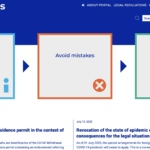
Entry/Exit System (EES) – Changes in Border Control for Third-Country Nationals
Poland is preparing to implement a new border control system, the Entry/Exit System (EES), which is part of the broader strategy of the European Union under Smart Borders. This system aims to enhance security levels while streamlining entry and exit procedures for third-country nationals visiting the Schengen Area for short stays.
Scope of Application of the EES System
The EES will apply to all third-country nationals crossing the EU borders for short stays—up to 90 days in any 180-day period. It will be relevant both for travelers subject to visa requirements and for those benefiting from visa liberalization agreements.
Data Collected in the EES System
As part of the functioning of the EES, various categories of data will be collected, stored, and processed, including:
- Alphanumeric Data:
- surname and first name,
- date of birth,
- citizenship,
- sex,
- type and number of travel document(s),
- three-letter code of the issuing state,
- an expiration date of the document,
- visa sticker number for short-stay visas.
- Biometric Data:
- facial image,
- fingerprints.
- Additional Data:
- information regarding entry/exit,
- data concerning entry refusals,
- status: a family member of a Union citizen.
Data Storage
Data collected in the EES will be stored for a period of three years for travelers who comply with the regulations regarding the permitted duration of stay in the Schengen Area. For third-country nationals who have overstayed their permitted time, the data will be archived for five years.
Functionality of the System
The EES is a system that automatically records each border crossing by third-country nationals, replacing traditional passport stamps. It operates by collecting biometric and alphanumeric data at the moment of entry and exit from the Schengen Area. The system also allows for automatic monitoring and calculation of the permitted duration of stay through a built-in calculator, preventing accidental violations of regulations.
Access to Data
The information collected in the EES will be utilized by various authorities and institutions responsible for maintaining public order and managing borders, including courts, prosecutors, governors, the Border Guard, the Police, the Head of the Office for Foreigners, and the National Revenue Administration. Thus, the EES is designed to enable more effective migration management and ensure a higher level of security within the Schengen Area.
Planned Benefits for Third-Country Nationals
For travelers from outside the European Union, the EES aims to significantly enhance the efficiency of border control. Key benefits include reduced waiting times for processing, which should improve traveler comfort and facilitate the entry and exit process.
The collection and storage of data in digital form will contribute to minimizing the risk of errors that can occur in traditional processes, such as manual passport stamping. With automation and the application of biometric technology, the border-crossing process will become more transparent and organized.
However, whether the system will indeed streamline the entire border-crossing process remains to be verified in practice. Any changes require time to fully assess their impact on travelers and the management of external borders of EU countries and the Schengen Area.
Conclusion
The Entry/Exit System introduces modern technological solutions that enhance the security of the European Union’s borders while facilitating travelers’ compliance with immigration regulations. The new regulations require third-country nationals to be aware of the data collection processes that will be processed and stored in the EES, as well as to utilize the built-in calculator for calculating the duration of stay in the Schengen Area.
Third-country nationals should pay particular attention to the new procedures and prepare for the implementation of the system in the near future.
Author: Konstancja Szkudlarek



